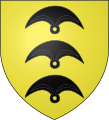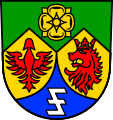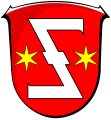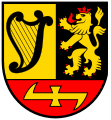Wolfsangel
 Reconstruction of a historical wolf trap, the original Wolfsangel | |||||
Horizontal and vertical Wolfsangels and Hameçon | |||||

The Wolfsangel (German pronunciation: [ˈvɔlfsˌʔaŋəl]) is a German heraldic charge inspired by historic wolf traps, consisting of two metal parts and a connecting chain. The top part of the trap, which resembled a crescent moon with a ring inside, used to be fastened between branches of a tree in the forest while the bottom part, on which meat scraps used to be hung, was a hook meant to be swallowed by a wolf. The simplified design based on the iron "wolf-hook" was often heavily stylized to no longer resemble a baited hook hung from a tree or an entire wolf trap. Other names included Wolfsanker ("wolf-anchor") or Wolfsjagd as well as hameçon or hameçon de loup, a half-moon shape with a ring, or as cramp or crampon in English with a ring at the center, sometimes also called Doppelhaken ("double-hook"), or a crampon with a transversal stroke. All of these symbols are still found in a number of municipal coats of arms in Germany. The crampon is also found as a mason's mark in medieval stonework.[1][2]
In early times, believed to possess magical powers, it became a symbol of liberty and independence after its adoption as an emblem of a peasant revolt in the 15th century against the oppression of the German princes and their mercenaries.[3] The Wolfsangel was an initial symbol of the Nazi Party.[4] In World War II, the sign and its elements were used by various German SS armoured and infantry divisions such as the Waffen-SS Division Das Reich and the Waffen-SS Division Landstorm Nederland.[4] In pre-war Germany, the Wolfsangel was partly inspired by the immense popularity of Hermann Löns's 1910 novel Der Wehrwolf during the 1930s, where the protagonist, a resistance fighter during the Thirty Years' War, adopted the magic symbol as his personal badge. The symbol itself bears a visual resemblance to the Eihwaz rune, historically part of the runic alphabet.[4]
Heraldry[]
The name Wolfsangel appears in a 1714 heraldic handbook, Wappenkunst, associated with a symbol distinct from the one presently known under this name. It is described as a crescent moon with a ring inside, at mid-height. Although written for the Wolfsangel, it is referring to the anchor of the Wolfsangel and not the "Wolf's-hook" proper.[5]
In modern German-language heraldic terminology, the name Wolfsangel is de facto used for a variety of heraldic charges, including the hameçon described above – a half-moon shape with a ring also called Wolfsanker and Wolfshaken; as well as the crampon – a Z shape or double-hook symbol also called Mauerhaken or Doppelhaken; and the Ƶ or double-hook symbol with a ring or transversal stroke at the center. It is only this symbol that also goes under the name Wolfsangel in the context of Neo-Nazism and occultism.
The crampon symbol is found comparatively frequently in municipal coats of arms in Germany, where it is often identified as Wolfsangel. The "crampon with central stroke" design is more rare, but is still found in about a dozen contemporary municipal coats of arms.[5]

Wolfisheim town (Alsace region of France) coat of arms

A heraldic hameçon in the arms of the von Stein family

A heraldic crampon in the municipal arms of Mannheim, Baden-Württemberg

Municipal arms of Erwitte, North Rhine-Westphalia

Municipal arms of Halberstadt, Saxony-Anhalt

Municipal arms of Idar-Oberstein, Rhineland-Palatinate

Municipal arms of Marpingen, Saarland

Municipal arms of Oestrich-Winkel, Hesse

Municipal arms of Mommenheim, Rhineland-Palatinate

Municipal arms of Dassendorf, Schleswig-Holstein

Municipal arms of Ilvesheim, Baden-Württemberg

Municipal arms of Sibbesse, Lower Saxony

Municipal arms of Eppelborn, Saarland

Municipal arms of Burgwedel, Lower Saxony

Municipal arms of Kleinblittersdorf, Saarland
As boundary marker and "forestry symbol"[]

In a 1616 boundary treaty concluded between Hesse and Brunswick-Lüneburg, the Brunswick boundary marker was called Wulffsangel. It was used not only on landmarks, but there is also evidence of its use in correspondence from the Forest Services in 1674.[citation needed]
Later the Wolfsangel was also used as a symbol on forest uniforms. In a document of 1792 regarding new uniforms, chief forester Adolf Friedrich von Stralenheim suggested a design for uniform buttons including the letters "GR" and a symbol similar to the Wolfsangel, which he called Forstzeichen. Later the Wolfsangel was also worn as a single badge in brass caps on the service and on the buttons of the Hanoverian forest supervisor. In Brunswick it was prescribed for private forest and gamekeepers also as badge on the bonnet.[6]
The Wolfsangel is still used the various forest districts in Lower Saxony as a boundary marker, and it is part of the emblem of the state of Lower Saxony and the hunters' association Hirschmann, dedicated to the breeding and training of Hanover Hounds.[6]
In literature[]
In 1910, Hermann Löns published a book entitled Der Wehrwolf (later published as Harm Wulf, a peasant chronicle and The Warwolf in English) set in a 17th-century German farming community during the Thirty Years' War.
As a Nazi symbol[]

In Nazi Germany, the Wolfsangel was used by:
- the 19th Infantry Division (Wehrmacht)
- the 19th Panzer Division (Wehrmacht)
- the 33rd Infantry Division (Wehrmacht)
- the 206th Infantry Division (Wehrmacht)
- the 256th Infantry Division (Wehrmacht)
- the 2nd SS Panzer Division Das Reich
- the 4th SS Polizei Panzergrenadier Division
- the 34th SS Volunteer Grenadier Division Landstorm Nederland
- the Sturmabteilung "Feldherrnhalle" Wachstandart Kampfrunen (Assault Unit—SA--"Warlord's Hall" Guard Regiment)
- the NS-Volkswohlfahrt organization
- the Flämische Nazionalsozialistische Kraftfahr Korps (Vlaamsche NSKK)
- the "Vlaamse wacht" / zwarte brigade (Flemish guard / Black brigade)
- the "Dietse Militie" (Dietsch militia)
- the Nationaal-Socialistische Beweging NSB, Dutch Nazi fascist party
- the Werwolf plan of resistance against allied occupation was intended to use this symbol.[7]
After World War II[]

Public exhibition of the symbol is illegal in Germany if a connection with one of these groups is apparent.[8][9] After World War II, the symbol was used by some Neo-Nazi organizations. In the United States the Aryan Nations organization uses a white Wolfsangel symbol with a sword replacing the cross-bar in its logo.[10]

A similar sign was used in Ukraine by the Social-National Party of Ukraine,[11][12][13] Social-National Assembly.[14] and Azov Battalion.[15][16][17][18] Group members claim that the symbol is an abbreviation for the slogan Ідея Нації (Ukrainian for "National Idea") and deny connection with National Socialism.[19]
On August 9, 2018, Germany lifted the ban on the usage of swastikas and other Nazi symbols in video games. "Through the change in the interpretation of the law, games that critically look at current affairs can for the first time be given a USK age rating," USK managing director Elisabeth Secker told CTV. "This has long been the case for films and with regards to the freedom of the arts, this is now rightly also the case with computer and videogames."[20][21]
In 2020, there was a brief trend of Gen Z TikTok users tatooing a "Generation Ƶ" symbol on the arm as "a symbol of unity in our generation but also as a sign of rebellion". The originator of the trend later renounced it when the similarity of the symbol to the Wolfsangel was brought to her attention.[22]
See also[]
- Black Sun (symbol), an associated symbol frequently used by neo-Nazi, alt-right, and white nationalist groups
- Fascist symbolism
- SS unit insignia
- Z with stroke
References[]
- ^ Press release of the Regional Association of Westphalia-Lippe, 30 October 2009 No original ancient specimens of such hooks were known prior to 2009 when excavations at the Falkenburg ruin in Detmold yielded more than 25 wolf hooks dated to the 13th century. Video on YouTube
- ^ Störk, Werner. "Wolf-Wolfsjagd-Wolfsangel-Wolfseisen-Wolfsgrube-Luder". Retrieved 7 December 2016.
- ^ Lumsden, Robin (1993). The Allgemeine-SS. Osprey Publishing. p. 18. ISBN 9781855323582.
- ^ Jump up to: a b c Lumsden, Robin (2009). Himmler's SS: Loyal to the Death's Head. The History Press. pp. 201–206. ISBN 978-0752497228. Retrieved 24 March 2015 – via Google Books.
- ^ Jump up to: a b Gustav Adelbert Seyler (1890). "Geschichte der Heraldik (Wappenwesen, Wappenkunst und Wappenwissenschaft) ... Abt. A. des Siebmacher'schen Wappenbuches". Bauer & Raspe. p. 664. Retrieved 12 June 2015.
Wolffs-Angel, frantz. hamecon, lat. uncus quo lupi capiuntur, ist die Form eines halben Mondes und hat inwendig in der Mitte einen Ring. Wolffs-Angel: French hameçon, Latin uncus quo lupi capiuntur ("hook with which wolves are caught") is the shape of a crescent moon with a ring inside, at mid-height.
- ^ Jump up to: a b Gerhard Große Löscher: Die Wolfsangel als Forst- und Jagdzeichen in Niedersachsen. In: Jürgen Delfs u. a.: Jagd in der Lüneburger Heide. Beiträge zur Jagdgeschichte. Celle 2006, ISBN 3-925902-59-7, 238–239
- ^ Watt, Roderick (October 1992). "Wehrwolf or Werwolf? Literature, Legend, or Lexical Error into Nazi Propaganda?". The Modern Language Review. 87 (4). doi:10.2307/3731426. JSTOR 3731426.
A study of the iconography of German nationalist groups between the wars and then of Nazi party, military, and paramilitary organizations from 1933 to 1945 proves beyond doubt that the 'Wolfsangel' symbol was widely, even indiscriminately used by them long before the formation of the Nazi Werwolf movement at the end of the war. Wolfsangel, if at all translatable, means, or at least originally meant, 'wolf trap', an instrument which is a threat to the wolf. Yet both Lons and the Nazis used it as a menacing symbol of intimidation representing the savage and relentless ferocity of the wolf... In the late summer or early autumn of 1944, when it was clear that Germany was committed to a European land war on two fronts, Reichsführer-SS Heinrich Himmler initiated Unternehmen Werwolf, ordering SS-Obergruppenführer Prutzmann to begin organizing an elite troop of volunteer special forces to operate secretly behind enemy lines.
- ^ "In Deutschland verbotene Zeichen und Symbole". Informations- und Dokumentationszentrum für Antirassismusarbeit in Nordrhein-Westfalen.
- ^ "Gruppierungen auf dem Index". Programm Polizeiliche Kriminalprävention.
- ^ "Aryan Nations". Anti-Defamation League. Retrieved 7 December 2016.
- ^ "Kyiv's Next Image Problem". Open Democracy. Retrieved 7 December 2016.
- ^ Analysing Fascist Discourse: European Fascism in Talk and Text,Per Anders Rudling “The Return of the Ukrainian Far Right: The Case of VO Svoboda" edited by Ruth Wodak, John E. Richardson. Routledge, 2012
- ^ Olszański, Tadeusz A. (4 July 2011). "Svoboda Party – The New Phenomenon on the Ukrainian Right-Wing Scene". Centre for Eastern Studies. OSW Commentary (56)
- ^ "Provoking the Euromaidan". Open Democracy. Retrieved 7 December 2016.
- ^ "Look far right, and look right again". Open Democracy. Retrieved 7 December 2016.
- ^ Alec Luhn (30 August 2014). "Preparing for War With Ukraine's Fascist Defenders of Freedom". Foreign Policy. Retrieved 8 August 2015.
- ^ Andrew E. Kramer (13 December 2014). "A Pastor's Turn Fighting for Ukraine". The New York Times. Retrieved 8 August 2015.
- ^ Parfitt, Tom (11 August 2014). "Ukraine crisis: the neo-Nazi brigade fighting pro-Russian separatists". The Daily Telegraph. Retrieved 7 December 2016.
- ^ РБК-Україна (22 June 2015), Комбат "Азова" заперечує зв'язок символіки батальйону з нацизмом. (in Ukrainian)
- ^ https://www.telegraph.co.uk/news/2018/08/09/germany-lifts-ban-nazi-symbols-video-games/. Missing or empty
|title=(help) - ^ https://www.pcgamer.com/germany-lifts-ban-on-swastikas-in-videogames/. Missing or empty
|title=(help) - ^ https://nypost.com/2020/09/26/gullible-tiktok-users-get-gen-z-tattoo-unaware-its-a-nazi-symbol/. Missing or empty
|title=(help)
Sources[]
- K. von Alberti (1960). Die sogenannte Wolfsangel in der Heraldik (in German). Südwestdeutsche Blätter für Familien und Wappenkunde. p. 89.
- H. Horstmann (1955). Die Wolfsangel als Jagdgerät und Wappenbild (in German). Vj. Bl. d. Trierer Gesellschaft für nützliche Forschungen.
External links[]
| Wikimedia Commons has media related to Wolfsangel. |
| Wikimedia Commons has media related to Wolfsangel. |
- Heraldic charges
- Nazi symbolism
- Fascist symbols
- White nationalist symbols



















